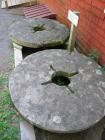22
Two Runner Stones of Wallace Sandstone, Balmoral, Nova Scotia, Canadamid 1800's
Balmoral, Nova Scotia, Canada
 Credits:
Credits:S. Brinkhurst
23
Grindstones needed to be only several inches (about 17cm) thick; the grey sandstone layers found at Balfron were about 1ft-2ft (31cm-61cm) thick and therefore needed to be reduced to thinner slabs. Sandstone splits easily along the bedding planes.These grindstones were made in the mid 1800's.A series of holes along the edge of the stone were drilled to a depth of about 6 inches (15cm) using a small steel drill having a sharpened square point. The drills were struck in turn with a 5lb (2.27kg) hammer, until the rock split along the line of holes. The drills or pins were known as 'gabs' and made locally by Findlay Ross, the blacksmith at the Falls. The rough stone was moved to the Logan Murphy home for finishing. Placed on a large wooden block, the center was determined and marked. Using a handmade compass the circumference of the grindstone was marked and the stone dressed to these marks by means of stone picks and chisels. A square hole was cut in the center which enabled the miller to mount it on a shaft, so it was supported and could be turned. A person working alone could make two grindstones a day. The Murphy family made a team wagon load, about a ton of grindstones, a week which they took to Westville, Pictou County, for sale.
Chambers Brook quarries were of various qualities, some usable for scythe stones, and some made excellent whetstones.